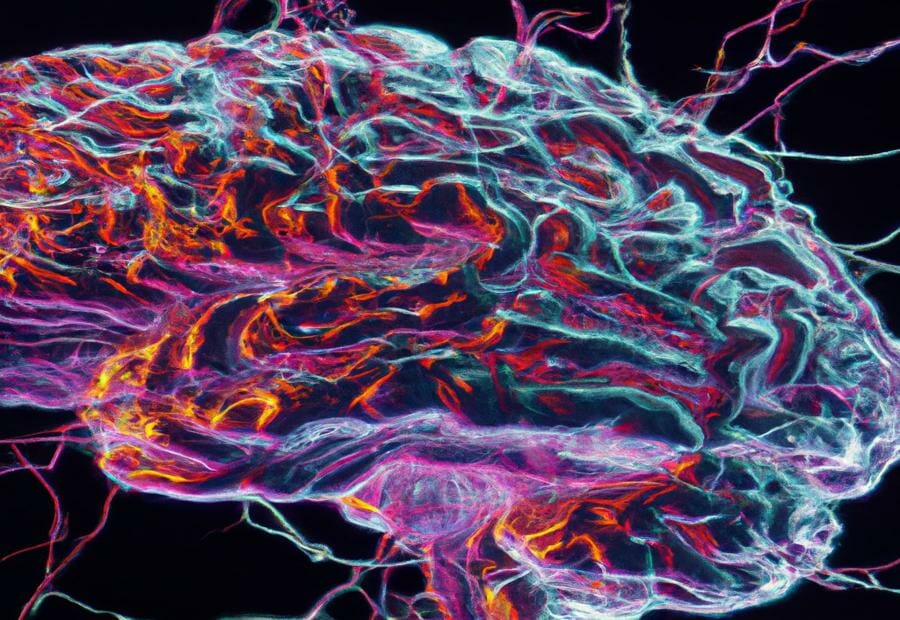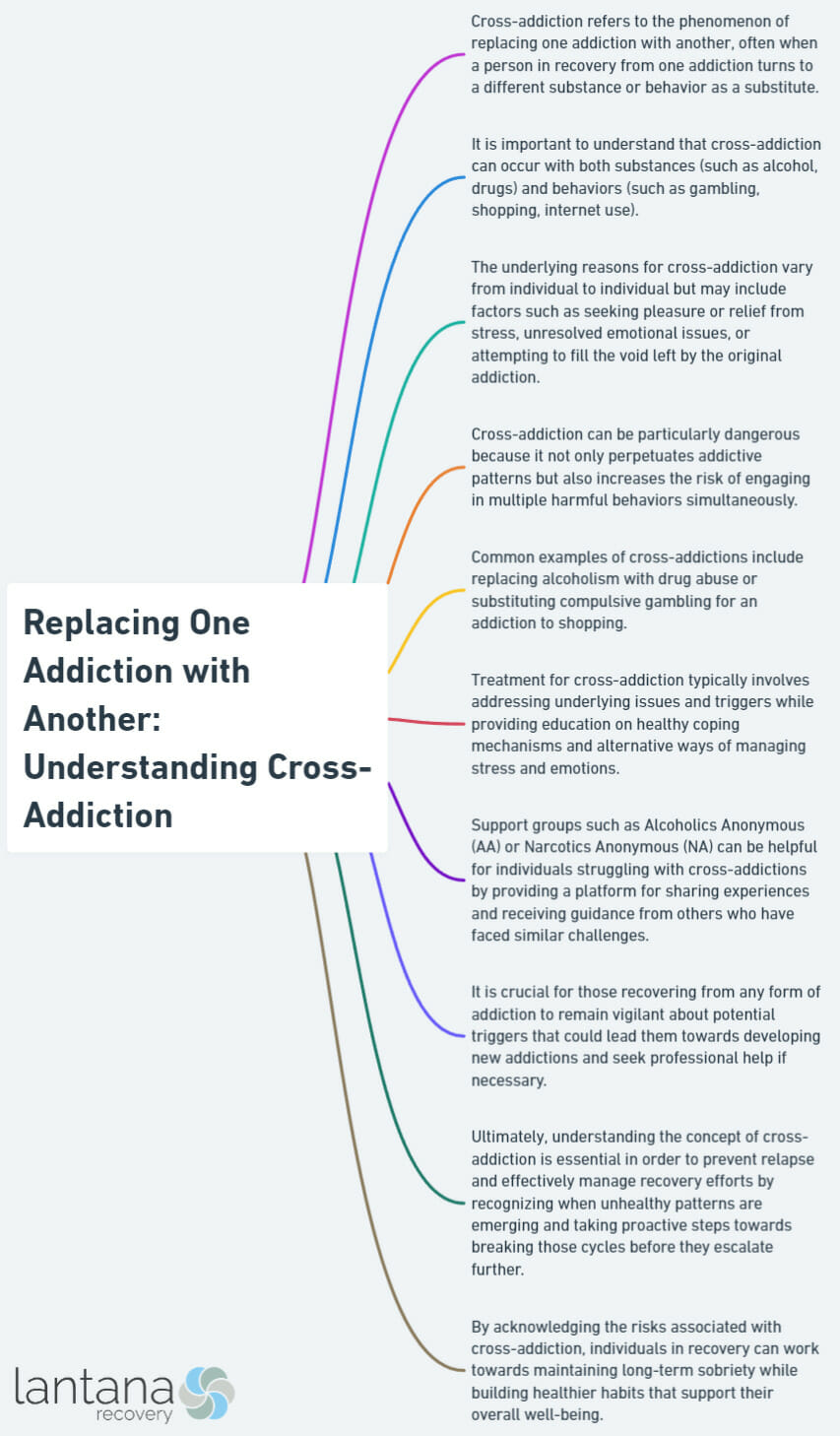Cross-addiction, a phenomenon often misunderstood, refers to the substitution of one addiction with another. It is essential to comprehend this concept to effectively address and overcome addictive behaviors. Driven by various factors, cross-addiction can manifest in different forms, such as alcohol and drug cross-addiction, gambling and substance cross-addiction, and food and substance cross-addiction.
Understanding the difference between cross-addiction and switching addictions is crucial. While switching addictions involves replacing one addiction with a different one, cross-addiction refers to the development of multiple addictions simultaneously or sequentially.
Several factors contribute to cross-addiction, including neurological factors, genetic predisposition, psychological factors, and environmental factors. These factors interplay to influence an individual’s susceptibility to developing cross-addictions.
Recognizing cross-addiction involves identifying behavioral patterns and understanding triggers and cues that lead to addictive behaviors. By recognizing these patterns and triggers, individuals can take necessary measures to prevent and address cross-addiction.
The cycle of cross-addiction typically follows four phases: the escalation phase, impact phase, crisis phase, and recovery phase. Understanding this cycle can provide insights into the progression and stages of cross-addiction, allowing individuals to take proactive steps towards recovery.
Prevention and treatment of cross-addiction involve developing healthy coping mechanisms to replace addictive behaviors, seeking professional help through therapy or counseling, and building a strong support network. These strategies aid individuals in breaking the cycle of cross-addiction and achieving long-term recovery.
By comprehending the complexities of cross-addiction and implementing effective prevention and treatment strategies, individuals can overcome the destructive cycle of addiction and lead healthier and more fulfilling lives.

What is Cross-Addiction?
Discovering the world of cross-addiction opens our eyes to the complex nature of this phenomenon. In this section, we’ll dive into the essence of cross-addiction, probing its definition and unraveling the distinctions between cross-addiction and merely switching addictions. Prepare to gain insight into the intricate web of addictive behaviors and the impact it can have on individuals. Get ready to explore a topic riddled with surprises, one that challenges our understanding of addiction as we know it.
Definition of Cross-Addiction
The definition of cross-addiction refers to developing multiple addictions to substances or behaviors. It occurs when a person already addicted to one substance or behavior develops an addiction to another. Cross-addiction involves the coexistence of multiple addictions, unlike switching addictions where one addiction is replaced by another. For example, an individual struggling with alcoholism may also find themselves battling addictions to drugs or gambling. It is essential to recognize and understand cross-addiction for prevention and treatment.
By identifying patterns and triggers, individuals can proactively take steps to break the cycle. Developing healthy coping mechanisms, seeking professional help, and building a strong support network are vital for prevention and management. When seeking treatment, it is important to address all addictions simultaneously for long-term recovery and to prevent the transfer of addictive behaviors.
Difference between Cross-Addiction and Switching Addictions
The contrast between cross-addiction and switching addictions is quite significant. Cross-addiction pertains to the development of additional addictions to substances or activities other than the original addictive behavior. It occurs when an individual with a pre-existing addiction forms another addiction, often due to shared underlying factors or a similar reward system in the brain.
On the other hand, switching addictions involves substituting one addictive behavior with another. This can happen when someone discontinues one addictive behavior and replaces it with a different one, usually as a result of seeking alternative methods to cope with underlying issues or cravings.
Understanding this distinction is crucial because it highlights the intricacy of addiction and how it can manifest in various forms. It emphasizes the necessity to address underlying factors that contribute to addictive behaviors rather than simply switching or substituting one addiction for another. It also underscores the potential risks associated with developing multiple addictions and the importance of comprehensive treatment approaches.
By acknowledging the disparity between cross-addiction and switching addictions, individuals can gain insight into their own behaviors and make well-informed decisions about seeking appropriate support and treatment to promote lasting recovery and well-being.
Common Types of Cross-Addiction

When it comes to cross-addiction, understanding the common types is crucial. From alcohol and drug cross-addiction to gambling and substance cross-addiction, and even food and substance cross-addiction, each sub-section sheds light on the various ways in which addictions can intertwine. So buckle up and prepare to delve into the intricate web of cross-addiction to gain a deeper understanding of this complex phenomenon, backed by facts and real-life examples.
Alcohol and Drug Cross-Addiction
Alcohol and Drug Cross-Addiction occurs when a person becomes addicted to both alcohol and drugs simultaneously. This addiction can have serious physical and mental health consequences. Here are some key points to consider:
-
Effects on the body: Alcohol and drug cross-addiction can cause health problems like liver damage, cardiovascular issues, respiratory complications, and impaired cognitive functions.
-
Increased tolerance: Individuals with cross-addictions may develop a tolerance to both alcohol and drugs, needing higher doses to achieve desired effects. This can lead to a dangerous cycle of escalating substance abuse.
-
Risk of overdose: Combining alcohol and drugs significantly increases the risk of overdose. The substances can interact in the body, intensifying their effects and potentially leading to life-threatening situations.
-
Impact on mental health: Cross-addiction often co-occurs with mental health disorders like depression, anxiety, and bipolar disorder. Substance abuse can worsen these conditions and hinder effective treatment.
-
Treatment options: Seeking professional help is crucial for individuals struggling with alcohol and drug cross-addiction. Treatment may include detoxification, therapy, support groups, and medication-assisted treatment.
If you or someone you know is dealing with alcohol and drug cross-addiction, it’s essential to reach out for help. Developing healthy coping mechanisms, seeking professional guidance, and building a support network can greatly enhance the recovery process. Remember, you don’t have to face this alone.
Gambling and Substance Cross-Addiction
Gambling and substance cross-addiction refer to the situation when an individual is addicted to both gambling and substances like drugs or alcohol. The role of impulsivity is significant in driving people to develop addictions to both gambling and substances simultaneously. This type of cross-addiction is often accompanied by underlying psychological issues such as depression or anxiety, as individuals turn to substances as a means of coping with emotional challenges.
Research indicates that individuals with a gambling addiction have a higher likelihood of also developing a substance use disorder. Approximately 73%% of those with a gambling addiction also struggle with alcohol abuse, reports a study published in the Journal of Clinical Psychiatry.
Early intervention is crucial in identifying the signs of gambling and substance cross-addiction. Increased secrecy, financial problems, and a preoccupation with gambling or substance use are behavioral patterns that should be recognized. Understanding triggers and cues can assist individuals and their loved ones in seeking prompt help.
To address gambling and substance cross-addiction, it is essential to seek professional help and develop healthy coping mechanisms. Establishing a support network can provide emotional support throughout the recovery process.
By simultaneously addressing both gambling and substance addictions, individuals can improve their chances of successful recovery and cultivate a healthier and more fulfilling life.
Food and Substance Cross-Addiction
Food and substance cross-addiction is a complex condition in which an individual develops addictive behaviors towards both food and substances such as drugs or alcohol. This type of addiction presents unique challenges as it involves two different types of addictive behaviors.
Food addiction is characterized by an unhealthy relationship with food, often leading to compulsive overeating or binge eating. On the other hand, substance addiction involves dependence on drugs or alcohol to achieve psychological and physical effects.
In the case of food and substance cross-addiction, individuals may turn to food as a means of coping with stress or managing their emotions, much like the use of substances. Both food and substances can provide temporary relief and pleasure, which ultimately perpetuates the addictive cycle.
The development of cross-addiction can be influenced by various factors, including neurological aspects such as the activation of reward pathways in the brain by both food and substances. Additionally, genetic predisposition may make certain individuals more susceptible to addictive behaviors. Psychological factors, including underlying mental health conditions, and environmental factors such as a history of trauma or an unhealthy home environment, can also contribute to the development of cross-addiction.
Interestingly, studies have shown that individuals with food and substance cross-addiction are more likely to struggle with managing their weight and have an increased risk of developing eating disorders. This further highlights the complexities and negative consequences of this type of addiction.
Factors Contributing to Cross-Addiction
When it comes to cross-addiction, understanding the factors that contribute to this complex phenomenon is crucial. In this section, we will explore the various elements that play a role in cross-addiction. From neurological factors to genetic predisposition, psychological influences, and environmental triggers, each sub-section will shed light on the different aspects that can contribute to the development of cross-addiction. Get ready to dive into the interconnected web of factors that shape this intricate and challenging issue.
Neurological Factors
Neurological factors play a significant role in cross-addiction. The brain’s reward system is heavily involved in addiction, and neurological processes specifically contribute to addictive behaviors. One crucial factor is neurotransmitters, such as dopamine, which is a pleasure and reward neurotransmitter. Neurological factors can influence dopamine levels, thereby increasing the risk of addiction by disrupting dopamine receptors or reducing dopamine transporters.
Moreover, addiction involves specific brain regions, including the prefrontal cortex, amygdala, and nucleus accumbens. The prefrontal cortex, responsible for decision-making and impulse control, may exhibit decreased functionality in individuals prone to addiction. Additionally, the amygdala, which plays a role in emotional processing, heightens cravings during addiction.
Furthermore, prolonged drug or alcohol use can alter neural plasticity, impacting how the brain adapts and regulates reward circuits, reports a study by Nora D. Volkow, Director of the National Institute on Drug Abuse (NIDA) in her study The Neuroscience of Drug Reward and Addiction. These changes contribute to cravings, tolerance, and withdrawal symptoms experienced in addiction. Genetic predisposition is also a significant neurological factor. Certain genes influence how the brain responds to substances, increasing the susceptibility to addictive behaviors.
Additionally, neurological factors affect the stress response system, thereby making stress a common trigger for addiction. Chronic stress leads to alterations in the brain’s reward system, causing individuals to seek relief through addictive substances or behaviors.
Understanding these neurological factors in cross-addiction sheds light on the complexity of addiction and its impact on the brain. By addressing these factors in prevention and treatment, individuals can receive more targeted and effective interventions.
Genetic Predisposition
Genetic predisposition plays a significant role in the development of cross-addiction. Research has shown that some individuals are more genetically predisposed to addiction. Studies have identified specific genes that contribute to the risk of addiction. For instance, variations in the DRD2 gene have been associated with an increased susceptibility to nicotine and alcohol addiction, reported by a study published in the BMC Medical Genetics journal. Another gene, COMT, has been linked to a higher likelihood of addiction to substances like cocaine and opioids.
It’s important to note that having a genetic predisposition does not guarantee the development of addiction. Environmental factors and personal choices also play a part. However, individuals with genetic predisposition may be more susceptible to addictive substances, which can make it easier for addiction to develop when exposed to them.
If you have a family history of addiction or suspect a genetic predisposition, it’s essential to be mindful of your choices and seek support. Understanding the increased risk can help you make informed decisions about substance use and take proactive steps to prevent addiction.
To minimize the risk of addiction when you have a genetic predisposition:
- Avoid experimenting with addictive substances, such as recreational drugs or excessive alcohol consumption.
- Engage in healthy coping mechanisms, like exercise, mindfulness, or creative outlets, to manage stress and emotional challenges.
- Build a strong support network of friends, family, and professionals who can offer guidance and assistance if needed.
- If your substance use becomes a concern, seek professional help from addiction specialists or therapists who can provide appropriate interventions and treatment options.
By being aware of your genetic predisposition and taking proactive measures, you can reduce the likelihood of cross-addiction and lead a healthier and more fulfilling life.
Psychological Factors
Psychological factors play a significant role in influencing cross-addiction. These factors have a profound impact on a person’s susceptibility to developing new addictions following recovery from an initial addiction. It is crucial to understand these factors in order to help individuals recognize and address their addictive behaviors effectively.
- Emotional distress: Stress, anxiety, and depression all contribute to cross-addiction. Individuals often resort to substances or activities as a means of coping with negative emotions.
- Low self-esteem: People with low self-esteem are particularly susceptible to developing cross-addictions. They seek validation and an escape from negative feelings through engaging in addictive behaviors.
- Poor impulse control: Some individuals struggle with controlling their impulses, which makes them highly vulnerable to cross-addictions. They find it challenging to resist immediate gratification and engage in impulsive behaviors without considering the potential consequences.
- Co-occurring mental health disorders: Co-occurring disorders such as bipolar disorder or borderline personality disorder are additional psychological factors that increase the risk of cross-addictions. These disorders may lead individuals to self-medicate or use substances or behaviors as a way to alleviate their symptoms.
- Conditioning and reinforcement: Conditioning and reinforcement greatly contribute to the development and perpetuation of addictive behaviors. Positive experiences associated with substances or behaviors reinforce addictive patterns, making it extremely difficult to break free from them.
Fact: Studies have shown that individuals with a history of psychological trauma are at a higher risk of developing co-occurring disorder. A clinical study conducted on 587 participants from at Grady Memorial Hospital in Atlanta, GA revealed a strong link between the both. “These data show strong links between childhood traumatization and SUDs, and their joint associations with PTSD outcome.” (Substance use, childhood traumatic experience, and Posttraumatic Stress Disorder in an urban civilian population, Khoury et al., 2010)
Traumatic experiences have a lasting impact on mental health and increase vulnerability to engaging in addictive behaviors.
Environmental Factors
Environmental factors play a crucial role in cross-addiction. These factors have an impact on both the susceptibility to addiction and the likelihood of engaging in various addictive behaviors. Some of the key environmental factors to consider include:
-
Availability of addictive substances: The accessibility of drugs, alcohol, or gambling establishments in an individual’s surroundings significantly contributes to cross-addiction. When these substances are easily obtainable, it increases the chances of experimentation and continued usage.
-
Social networks: Peer influence and social norms exert a powerful force on addictive behaviors. When an individual is surrounded by friends or family members who engage in addictive behaviors, the risk of cross-addiction is heightened.
-
Stressful environments: High levels of stress, whether stemming from work, relationships, or other sources, can contribute to cross-addiction. People may turn to different substances or activities in order to cope with stress or escape from reality.
-
Family history: Growing up in a family with a prevalent history of addiction increases the likelihood of cross-addiction. Both genetic and environmental factors within the family system contribute to the development of addictive behaviors.
-
Advertising and media influence: Media and advertising play a significant role in shaping perceptions and attitudes towards addictive substances or activities. Exposure to advertisements that promote addictive behaviors can influence individuals to engage in cross-addiction.
It is important to recognize that environmental factors alone do not solely determine cross-addiction. These factors interact with individual characteristics, such as genetic predisposition and psychological factors, to contribute to the development of addiction. Understanding and addressing these environmental factors are crucial for both prevention and treatment.

Recognizing Cross-Addiction
Recognizing Cross-Addiction is the key to breaking free from the cycle of dependency. In this section, we’ll dive into the behavioral patterns that can serve as red flags, as well as the triggers and cues that can lead to a harmful spiral. By identifying these subtle signs and understanding their impact, we can equip ourselves with the knowledge needed to navigate a healthier path towards recovery. Let’s explore the crucial aspects of cross-addiction and embrace the power of awareness.
Identifying Behavioral Patterns
Identifying Behavioral Patterns is crucial for understanding cross-addiction. By recognizing these patterns, individuals can address addictive behaviors and make positive changes in their lives.
- Pay attention to cravings: One behavioral pattern to look out for is intense cravings for a substance or behavior. These cravings can be triggered by situations, emotions, or thoughts. Identifying and acknowledging these cravings is the first step towards addressing cross-addiction.
- Notice changes in behavior: Another sign of cross-addiction is a change in behavior. This may include becoming secretive, withdrawing from social activities, or engaging in risky behaviors to obtain or engage in addictive behaviors.
- Identify triggers: It’s important to identify triggers that lead to addictive behaviors. These triggers can be internal, such as stress or negative emotions, or external, such as certain environments or people. Recognizing these triggers helps individuals develop coping strategies.
- Keep track of patterns: Keeping a journal or recording thoughts, feelings, and actions can help identify behavioral patterns. By documenting their experiences, individuals can identify trends and triggers contributing to their addictive behaviors.
- Seek professional help: If someone is struggling with cross-addiction, professional help from a therapist or counselor is essential. They can provide guidance, support, and effective strategies for overcoming addictive behaviors.
Pro-tip: Identifying behavioral patterns is the first step. Follow through with appropriate treatment and support to address cross-addiction effectively. Making lifestyle changes, building a strong support network, and seeking professional help can greatly increase the chances of successful recovery.
Understanding Triggers and Cues
Understanding Triggers and Cues is crucial in comprehending the cycle of Cross-Addiction and working towards prevention and treatment. Here are some key points to consider:
- Identifying Triggers: Recognizing triggers that lead to addictive behaviors is important to break the cycle. Triggers can vary and include stress, places, people, or emotions.
- External Cues: Specific sights, smells, sounds, or activities associated with the addiction can trigger addictive behaviors.
- Internal Cues: Thoughts or emotions can also act as triggers for addictive behaviors. Negative emotions like anxiety, loneliness, or boredom, as well as positive emotions like excitement or celebration, can prompt addictive behaviors.
- Awareness and Mindfulness: Developing self-awareness and mindfulness helps individuals recognize and manage triggers and cues. This involves being present in the moment, acknowledging cravings or urges, and consciously choosing healthier coping mechanisms.
- Coping Strategies: Cultivating healthy coping mechanisms effectively replaces addictive behaviors. These can include exercise, meditation, hobbies, seeking support from loved ones, or attending support groups.
- Therapeutic Techniques: Cognitive-behavioral therapy (CBT) aids in understanding triggers and cues. CBT helps individuals identify and challenge negative thought patterns and develop healthier ways of thinking and behaving.
By understanding triggers and cues, individuals gain insight into their addictive behaviors and take proactive steps towards breaking the cycle of Cross-Addiction.

The Cycle of Cross-Addiction
In the fascinating realm of cross-addiction, the cycle is a force to reckon with. Brace yourself as we delve into the different phases that compose this relentless cycle: the escalation phase, the impact phase, the crisis phase, and the recovery phase. Each phase holds its own significance in this intricate dance of addiction. So, buckle up and prepare to unravel the chaos and transformation that ensues as one addiction replaces another.
Escalation Phase
The escalation phase, a critical stage in the cycle of cross-addiction, is characterized by increasing addictive behaviors and a loss of control. During this phase, individuals become aware of the negative consequences of their addictive behaviors and may experience feelings of guilt, shame, or powerlessness.
As the addiction progresses, individuals may develop a tolerance and require more of the addictive substance or behavior to achieve the same satisfaction or relief. This dangerous cycle of escalating consumption can be challenging to resist, impairing decision-making abilities and causing individuals to prioritize their addiction above everything else.
Not only does the escalation phase take a toll on physical and mental well-being, but it also leads to various issues. Physical health problems, such as liver damage from excessive alcohol consumption, and psychological issues like increased anxiety or depression, can be experienced.
Addictive behaviors start to interfere with an individual’s daily life, causing them to neglect responsibilities, withdraw from social activities, or face financial difficulties due to their addiction.
During this phase, individuals may engage in riskier behaviors in their desperation to obtain the addictive substance or desired effect, which can lead to dangerous situations, legal problems, or harm to oneself or others.
As the addiction escalates, individuals tend to isolate themselves and deny the extent of their problem. They may become secretive or defensive about their addictive behaviors.
Recognizing the signs of the escalation phase and seeking help early on are crucial for successful recovery. If you or someone you know is experiencing the escalation phase of cross-addiction, it is important to reach out to a healthcare professional or addiction specialist for guidance and support.
Impact Phase
During the Impact Phase of cross-addiction, individuals experience significant negative consequences that affect various aspects of their lives. This critical stage magnifies the detrimental effects of their addictive behaviors on their physical, emotional, and social well-being.
- Relationships: The Impact Phase strains relationships with family, friends, and loved ones due to the individual’s preoccupation with addictive behaviors. Trust is broken, communication deteriorates, and emotional connections weaken.
- Finances: Addictive behaviors lead to financial difficulties in the Impact Phase. Excessive spending on addiction results in debt, missed bill payments, and financial instability.
- Health: The Impact Phase has severe consequences on physical and mental health. Substance abuse causes deteriorating physical health, increased risk of accidents or injuries, and the development or worsening of mental health disorders.
- Legal Issues: Addictive behaviors may result in legal problems, such as DUI charges, drug possession, or other criminal offenses. Legal consequences during the Impact Phase have long-lasting effects, including fines, probation, or imprisonment.
- Occupational or Academic Performance: Cross-addiction impacts work or school life. There is a decline in productivity, increased absenteeism, poor performance, and the potential loss of employment or educational opportunities.
Recognizing the negative consequences during the Impact Phase is crucial for motivation to seek help and make necessary changes. Addressing the underlying addiction through professional treatment provides individuals with the support and tools needed to recover from the impact of cross-addiction and rebuild their lives.
Crisis Phase
During the crisis phase of cross-addiction, individuals may experience severe consequences from their addictive behaviors. It is important to understand this crisis phase in order to effectively recognize and address cross-addiction. Here are the key aspects of the crisis phase:
- Emotional turmoil: The crisis phase is characterized by intense emotional distress. Individuals may feel overwhelmed, anxious, and depressed due to the negative consequences of their addictive behaviors.
- Relationship strain: Addictive behaviors can strain relationships with loved ones. Friends and family may become frustrated, disappointed, or angry, leading to increased conflict.
- Financial difficulties: The crisis phase often involves significant financial problems. Excessive spending on addictive behaviors can lead to debt, loss of employment, and overall financial instability.
- Legal issues: Addictive behaviors can result in legal repercussions. Engaging in illegal activities to support the addiction may lead to arrests, charges, and potential legal consequences.
- Physical and mental health deterioration: The crisis phase is associated with declining physical and mental health. Substance abuse and neglecting self-care can lead to deteriorating physical health. Additionally, the emotional toll can contribute to the development or worsening of mental health conditions.
- Loss of control: A defining characteristic of the crisis phase is the loss of control over addictive behaviors. Individuals may feel powerless, leading to a sense of hopelessness and desperation.
- Increased risk of harm: The crisis phase poses an increased risk of harm to oneself or others. This can manifest in self-destructive behaviors, suicidal ideation, or engaging in risky activities.
Understanding the crisis phase is critical in providing appropriate support and intervention for individuals struggling with cross-addiction.
Recovery Phase
In the recovery phase, individuals strive to overcome addictive behaviors and achieve a healthier lifestyle. This phase is crucial for long-term sobriety. Here are important factors to consider during the
| 1. Develop new coping mechanisms: |
| During the Recovery Phase, it is essential to identify healthy strategies to replace addictive behaviors. One can practice mindfulness, exercise, or engage in creative outlets. By doing so, individuals can cultivate healthier coping mechanisms to deal with triggers and cravings. |
| 2. Seek professional help: |
| Recovery often requires therapy with addiction specialists, support groups, or rehab programs. Seeking guidance from experts provides invaluable insights, support, and necessary tools to navigate through the Recovery Phase. |
| 3. Build a support network: |
| It is beneficial to surround yourself with friends, family, or individuals who have had similar experiences during the Recovery Phase. Having a strong support system offers encouragement, understanding, and accountability throughout the journey. |
| 4. Engage in self-care: |
| Taking care of oneself physically, emotionally, and mentally is vital during the Recovery Phase. Adopting healthy habits such as regular exercise, balanced nutrition, and sufficient sleep is essential. Additionally, prioritizing activities that bring joy, relaxation, and fulfillment can contribute to a successful recovery. |
| 5. Maintain a positive mindset: |
| Believing in one’s ability to overcome addiction is crucial during the Recovery Phase. By focusing on personal growth and self-improvement, individuals can boost their motivation and resilience. |
Remember, each person’s journey is unique, and progress may not always be linear. It is common to experience setbacks along the way. By staying committed, seeking support, and implementing healthy strategies, individuals can achieve lasting sobriety during the Recovery Phase.

Prevention and Treatment of Cross-Addiction
When it comes to understanding cross-addiction, one crucial aspect is prevention and treatment. In this section, we’ll explore various approaches to tackle this challenge head-on. We’ll delve into developing healthy coping mechanisms, the significance of seeking professional help, and the importance of building a strong support network. So, fasten your seatbelts and get ready to discover effective strategies for overcoming cross-addiction and fostering lasting recovery.
Developing Healthy Coping Mechanisms
Developing healthy coping mechanisms is crucial in preventing and managing cross-addiction. Find alternative ways to cope with stress, emotions, and triggers without turning to addictive substances or behaviors.
In order to develop healthy coping mechanisms, follow these steps:
- Identify triggers: Recognize the situations, people, or emotions that lead to cravings or the desire to engage in addictive behaviors. This awareness enables individuals to develop strategies to avoid or manage these triggers.
- Manage stress: Find healthy ways to cope with stress such as exercise, meditation, or relaxation techniques. These activities can reduce stress levels without relying on addictive substances.
- Build a support network: Surround yourself with a supportive community, seek help from professionals, attend support groups, or confide in trusted friends and family members. This network offers encouragement and guidance.
- Learn new skills: Engage in activities or hobbies that contribute to personal growth and fulfillment. Learning a musical instrument, painting, or writing can boost mental well-being and offer a healthy outlet for emotions.
- Prioritize self-care: Take care of yourself by getting enough sleep, eating a balanced diet, and engaging in regular physical activity. Self-care activities support overall well-being, reduce stress, and promote a healthy lifestyle.
Remember that developing healthy coping mechanisms takes time and effort. It may be helpful to work with a therapist or counselor who can provide guidance and support throughout the process.
Let’s look at Andrew’s story. Andrew successfully developed healthy coping mechanisms after struggling with cross-addiction. Realizing the destructive patterns in his life, he sought professional help. Through therapy, Andrew discovered new ways to manage stress and cope with emotions, such as journaling and mindfulness exercises. He also joined a support group where he found camaraderie and understanding. By incorporating these healthy coping mechanisms into his daily routine, Andrew was able to break free from the cycle of cross-addiction and live a fulfilling life in recovery.
Seeking Professional Help
When it comes to dealing with cross-addiction, it is absolutely crucial to actively seek professional help. Engaging with addiction treatment experts is an important part of seeking professional help. These professionals have the knowledge and experience needed to effectively guide individuals through the process of recovery.
One of the key benefits of professional help is access to therapists, counselors, and medical professionals who can assess individual needs and create a personalized treatment plan. These experts have a deep understanding of the complexities of cross-addiction and can address any contributing factors.
Furthermore, seeking professional help ensures that individuals receive evidence-based approaches to addiction treatment. This may include cognitive-behavioral therapy (CBT), motivational interviewing, and group therapy, all of which have been proven to be effective.
In situations where medication-assisted treatment or detoxification is necessary, professional help is absolutely essential. Medical professionals are able to provide the necessary medications and closely monitor individuals to manage withdrawal symptoms and reduce any potential complications.
Recent study by scientist at Yale School Medicine have revealed that medication assisted therapy (MAT) significantly reduces the risk of relapse and helps promote adherence to the treatment programs.
Another important aspect of professional help is the emotional support that is provided throughout the recovery journey. Therapists and counselors are able to help individuals address any underlying psychological issues and develop healthy coping mechanisms, skills, and strategies to prevent relapse.
By seeking professional help, individuals are able to benefit from a structured and accountable treatment environment. Regular sessions and check-ins help individuals stay on track, monitor their progress, and make any necessary adjustments to their treatment plan.
Ultimately, seeking professional help offers individuals with cross-addiction the guidance, support, and tools necessary to overcome their addiction and lead a healthier life.
Building a Support Network
When building a support network for overcoming cross-addiction, have people who understand, guide, and encourage. Here are key elements to consider:
- Identify individuals who relate to your struggles and have personal experience with addiction and recovery. They offer empathy, insight, and practical advice.
- Connect with addiction support groups like Alcoholics Anonymous (AA), Narcotics Anonymous (NA), or Gamblers Anonymous (GA). These groups provide a safe space to share experiences, learn from others, and gain support from those who faced similar challenges.
- Build relationships with supportive and understanding friends and family. Discuss goals and challenges with them, asking for their support when you need help with addiction.
- Consider seeking help from addiction counselors, therapists, or psychologists specializing in treating cross-addiction. They provide valuable guidance, evidence-based strategies, and personalized support.
- Utilize online resources and forums dedicated to addiction recovery. Engage with individuals going through similar experiences, sharing thoughts, concerns, and achievements.
- Stay engaged in positive activities and hobbies promoting a healthy lifestyle and contributing to overall well-being. This can include exercise, meditation, art, or any other joyful activity diverting attention from addictive behaviors.
Building a strong support network is crucial for overcoming cross-addiction. Surrounding yourself with understanding individuals who provide emotional support, practical advice, and accountability will enhance your chances of maintaining sobriety and achieving long-term recovery.

Frequently Asked Questions
FAQ 1: What is cross-addiction?
Answer: Cross-addiction occurs when a person in recovery replaces one addiction with another. This can happen because various substances and activities stimulate the brain’s pleasure center.
FAQ 2: What are some commonly substituted addictions?
Answer: Commonly substituted addictions include exercise addiction, food addiction, sex/love addiction, shopping addiction, gambling addiction, nicotine addiction, and work addiction.
FAQ 3: Why is replacing one addiction with another dangerous?
Answer: Replacing one addiction with another can be dangerous as it may lead to similar social, interpersonal, and psychological consequences. It is important to address the underlying causes of addiction and develop healthy coping strategies.
FAQ 4: How can one prevent cross-addiction?
Answer: To prevent cross-addiction, it is important to become aware of unhealthy habits and develop strategies to counteract them. It is also crucial to address the underlying causes of addiction and seek appropriate treatment and support.
FAQ 5: Where can I seek help for addiction or cross-addiction?
Answer: SAMHSA’s National Helpline is a confidential and free 24/7 treatment referral and information service for individuals and families facing mental and/or substance use disorders. They can provide referrals to local treatment facilities, support groups, and community-based organizations.
FAQ 6: How can I contact SAMHSA’s National Helpline?
Answer: SAMHSA’s National Helpline can be contacted at 1-800-662-HELP (4357) or TTY: 1-800-487-4889. The service is available in both English and Spanish and is open every day of the year.









